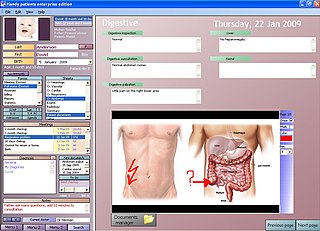
Oracle Corporation is an American multinational computer technology company headquartered in Austin, Texas, United States. In 2020, Oracle was the third-largest software company in the world by revenue and market capitalization. The company sells database software and technology, cloud engineered systems, and enterprise software products, such as enterprise resource planning (ERP) software, human capital management (HCM) software, customer relationship management (CRM) software, enterprise performance management (EPM) software, and supply chain management (SCM) software.

An electronic health record (EHR) is the systematized collection of patient and population electronically stored health information in a digital format. These records can be shared across different health care settings. Records are shared through network-connected, enterprise-wide information systems or other information networks and exchanges. EHRs may include a range of data, including demographics, medical history, medication and allergies, immunization status, laboratory test results, radiology images, vital signs, personal statistics like age and weight, and billing information.

Epic Systems Corporation, or Epic, is an American privately held healthcare software company. According to the company, hospitals that use its software held medical records of 78% of patients in the United States and over 3% of patients worldwide in 2022.

Google Health was a project by Google designed as an attempt to create a repository of health records and data in order to connect doctors, hospitals and pharmacies directly. The project was introduced in 2008 and discontinued in 2012. Google Health was restarted in 2018 but appeared to be discontinued in 2021 and was officially called an "effort" rather than a separate division as of 2022.
Banner Health is a non-profit health system in the United States, based in Phoenix, Arizona. It operates 30 hospitals and several specialized facilities across 6 states. The health system is the largest employer in Arizona and one of the largest in the United States with over 50,000 employees.
Patient portals are healthcare-related online applications that allow patients to interact and communicate with their healthcare providers, such as physicians and hospitals. Typically, portal services are available on the Internet at all hours of the day and night. Some patient portal applications exist as stand-alone web sites and sell their services to healthcare providers. Other portal applications are integrated into the existing web site of a healthcare provider. Still others are modules added onto an existing electronic medical record (EMR) system. What all of these services share is the ability of patients to interact with their medical information via the Internet. Currently, the lines between an EMR, a personal health record, and a patient portal are blurring. For example, Intuit Health and Microsoft HealthVault describe themselves as personal health records (PHRs), but they can interface with EMRs and communicate through the Continuity of Care Record standard, displaying patient data on the Internet so it can be viewed through a patient portal.
Health information technology (HIT) is health technology, particularly information technology, applied to health and health care. It supports health information management across computerized systems and the secure exchange of health information between consumers, providers, payers, and quality monitors. Based on a 2008 report on a small series of studies conducted at four sites that provide ambulatory care – three U.S. medical centers and one in the Netherlands, the use of electronic health records (EHRs) was viewed as the most promising tool for improving the overall quality, safety and efficiency of the health delivery system.
Athenahealth is a private American company that provides network-enabled services for healthcare and point-of-care mobile apps in the United States.

The Veterans Health Information Systems Technology and Architecture (VISTA) is the system of record for the clinical, administrative and financial operations of the Veterans Health Administration VISTA consists of over 180 clinical, financial, and administrative applications integrated within a single shared lifelong database (figure 1).
InterSystems Corporation is a privately held vendor of software systems and technology for high-performance database management, rapid application development, integration, and healthcare information systems. The vendor's products include InterSystems IRIS Data Platform, Caché Database Management System, the InterSystems Ensemble integration platform, the HealthShare healthcare informatics platform and TrakCare healthcare information system, which is sold outside the United States.

NextGen Healthcare, Inc. is an American software and services company headquartered in Atlanta, Georgia. The company develops and sells electronic health record (EHR) software and practice management systems to the healthcare industry. NextGen Healthcare also provides population health, financial management, and clinical solutions for medical and dental practices. On September 7, 2018, Quality Systems, Inc. changed its name to NextGen Healthcare, Inc. and on September 10, their stock ticker symbol changed to NASDAQ: NXGN.
AHLTA is a global Electronic Health Record (EHR) system used by U.S. Department of Defense (DoD). It was implemented at Army, Navy and Air Force Military Treatment Facilities (MTF) around the world between January 2003 and January 2006. It is a services-wide medical and dental information management system. What made AHLTA unique was its implementation date, its Central Data Repository, its use in operational medicine and its global implementation. There is nothing like it in the private sector.

Nightingale Informatix Corporation, commonly abbreviated as Nightingale, is a public company headquartered in Markham, Ontario, Canada with offices in Rancho Cordova, California, Cambridge, Ontario, Kansas City, Missouri, Pembroke, Massachusetts, and Wexford, Pennsylvania. Nightingale provides products and services that support physicians, allied healthcare practitioners, hospitals and other healthcare organizations with their clinical and operational requirements. Nightingale provides EHR and Practice Management services, as well as a Patient Portal, Revenue Cycle Management and Medical transcription services to solo physicians, group practices and large clinics across the United States and Canada. The EMR/ EHR by Nightingale is a web-based program and is hosted in a secure ASP environment.
American Well Corporation, doing business as Amwell, is a telemedicine company based in Boston, Massachusetts, that connects patients with doctors over secure video. Amwell sells its platform as a subscription service to healthcare providers to put their medical professionals online and its proprietary software development kits, APIs, and system integrations enable clients to embed telehealth into existing workflows utilized by providers and patients.
Netsmart Technologies is an American company that develops and sells health information technology, including for electronic health records and health information exchanges, for organizations and entities in the behavioral health, human services, and post-acute care markets.

Greenway Health, LLC is a privately-owned vendor of health information technology (HIT) including integrated electronic health record (EHR), practice management, and revenue cycle management solutions. Intergy, Greenway’s cloud-based EHR and practice management solution, serves ambulatory healthcare practices. The company has offices in Tampa, Florida; Carrollton, Georgia; and Bangalore, India.

The pharmacy management system, also known as the pharmacy information system, is a system that stores data and enables functionality that organizes and maintains the medication use process within pharmacies.
Servelec is a health informatics company based in Sheffield and owned by The Access Group. It supplies software to the healthcare, social care and education sectors.
Federal and state governments, insurance companies and other large medical institutions are heavily promoting the adoption of electronic health records. The US Congress included a formula of both incentives and penalties for EMR/EHR adoption versus continued use of paper records as part of the Health Information Technology for Economic and Clinical Health (HITECH) Act, enacted as part of the, American Recovery and Reinvestment Act of 2009.
Audacious Inquiry (Ai) is an American company founded in 2004 and with headquarters in Baltimore, Maryland. The company provides health information technology services and cloud-based software.











